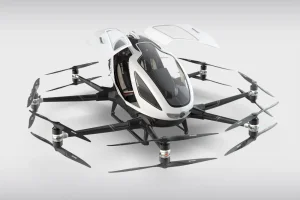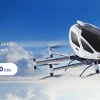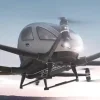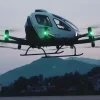- Directory
- Electrified Aircraft
- All-Electric Aircraft
- All Electric eVTOL
- Ehang EH216-S
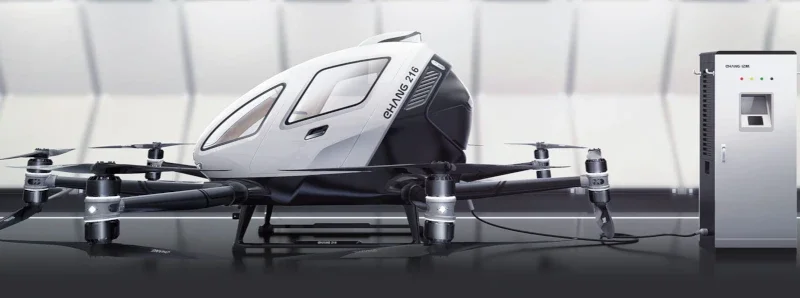
Ehang EH216-S
Hot
9338 2 4 0
Operational Information
Overview:
The EHang EH216-S is a leader in autonomous air mobility. This cutting-edge eVTOL features a dual-passenger capacity, autonomous flight technology, and a robust safety system, designed for urban air transport. Ideal for quick, efficient, and environmentally-friendly city commutes. Learn more about its features and urban air mobility potential.
Aircraft type:
Aircraft Model
EH216-S
Manufacturer
eHANG
Country
CHINA
Stock
NASDAQ: EH
Use Case
Crew
- Autonomous
Propulsion
- Electric Multicopter
Enter service date.
2025
Cost
$410,000
Website
http://www.ehang.com
Performance and Capacity
Propellers:
- 8 propellers
Motors
- Brushless DC electric motor (BLDC)
Power source:
- Battery
Battery system
- 12 Battery packs
- Lithium-ion
Passenger Capacity
2
Range
35 km (22 miles)
Maximum Range
18.6 Miles/30K
Cruise speed
100 km/h (62 mph)
Maximum Speed
130 km/h (81 mph)
Cruise altitude
NA
Maximum Altitude
3,000 m (9,843 ft)
Time to recharge
120 minutes
Maximum Takeoff Weight
1366 pounds./620kg
Aircraft Design and Dimensions
Height
6.33FT/1.93M
Width
18.8FT/5.73M
Cabin lenght
NA
Cabin height
NA
Cabin width
NA
EHang EH216-S:
The EHang EH216-S is a pioneering electric vertical takeoff and landing (eVTOL) aircraft designed to revolutionize urban air mobility (UAM) by offering an efficient and environmentally friendly alternative to traditional urban transport methods.
The EH216-S, manufactured by EHang, a company based in Guangzhou, China, has garnered attention for its fully autonomous flight capabilities, marking significant milestones in UAM technology and deployment.
Development
EHang's journey with the EH216-S began with a vision to alleviate congestion in urban centers through innovative aerial solutions. Advancements in drone technology and autonomous navigation systems drove the aircraft's development.
The EH216-S is a culmination of rigorous testing and refinements to ensure safety and reliability, with ongoing efforts towards achieving certification from global aviation authorities.
Performance and Capabilities
The EH216-S can carry two passengers at a maximum speed of 130 km/h and has a range of up to 35 kilometers. It requires approximately 1 hour to charge fully. The aircraft utilizes 16 independent rotors and motors, enhancing its stability and redundancy in urban environments. Its lightweight, compact design is specifically tailored for short-range city commutes.
Market Competition
In the burgeoning eVTOL market, the EH216-S competes with models like the Volocopter 2X and the Joby Aviation S4. Unlike some semi-autonomous or pilot-required counterparts, the EH216-S offers complete autonomy, positioning it uniquely as a fully unmanned air taxi solution. This autonomy allows for diverse applications, including air taxi services, emergency response, and logistics.
Development Progress and Future Outlook
The EH216-S has successfully transitioned from testing to actual production, with the recent attainment of the world's first Airworthiness Certificate for a pilotless passenger-carrying eVTOL aircraft from the Civil Aviation Administration of China (CAAC). This milestone confirms the EH216-S's compliance with stringent safety and quality standards, signaling its readiness for commercial operations. EHang has already begun commercial delivery of the certified EH216-S, initiating a new era in urban air mobility. Looking forward, EHang is poised to scale production to fulfill growing market demands and expand the applications of the EH216-S. The company envisions broadening its operational scope to include inter-city travel and integrating into intelligent city infrastructures. This expansion is part of a larger strategy to mainstream eVTOLs in everyday urban transportation, enhancing connectivity and reducing urban congestion.
Conclusion
The EHang EH216-S represents a significant leap forward in urban air mobility, promising to impact how cities manage transportation and mobility significantly. It is well-positioned to become a cornerstone of future urban transport systems, influencing urban planning and mobility strategies worldwide by providing a scalable, efficient, and eco-friendly transportation solution.
The EH216-S, manufactured by EHang, a company based in Guangzhou, China, has garnered attention for its fully autonomous flight capabilities, marking significant milestones in UAM technology and deployment.
Development
EHang's journey with the EH216-S began with a vision to alleviate congestion in urban centers through innovative aerial solutions. Advancements in drone technology and autonomous navigation systems drove the aircraft's development.
The EH216-S is a culmination of rigorous testing and refinements to ensure safety and reliability, with ongoing efforts towards achieving certification from global aviation authorities.
Performance and Capabilities
The EH216-S can carry two passengers at a maximum speed of 130 km/h and has a range of up to 35 kilometers. It requires approximately 1 hour to charge fully. The aircraft utilizes 16 independent rotors and motors, enhancing its stability and redundancy in urban environments. Its lightweight, compact design is specifically tailored for short-range city commutes.
Market Competition
In the burgeoning eVTOL market, the EH216-S competes with models like the Volocopter 2X and the Joby Aviation S4. Unlike some semi-autonomous or pilot-required counterparts, the EH216-S offers complete autonomy, positioning it uniquely as a fully unmanned air taxi solution. This autonomy allows for diverse applications, including air taxi services, emergency response, and logistics.
Development Progress and Future Outlook
The EH216-S has successfully transitioned from testing to actual production, with the recent attainment of the world's first Airworthiness Certificate for a pilotless passenger-carrying eVTOL aircraft from the Civil Aviation Administration of China (CAAC). This milestone confirms the EH216-S's compliance with stringent safety and quality standards, signaling its readiness for commercial operations. EHang has already begun commercial delivery of the certified EH216-S, initiating a new era in urban air mobility. Looking forward, EHang is poised to scale production to fulfill growing market demands and expand the applications of the EH216-S. The company envisions broadening its operational scope to include inter-city travel and integrating into intelligent city infrastructures. This expansion is part of a larger strategy to mainstream eVTOLs in everyday urban transportation, enhancing connectivity and reducing urban congestion.
Conclusion
The EHang EH216-S represents a significant leap forward in urban air mobility, promising to impact how cities manage transportation and mobility significantly. It is well-positioned to become a cornerstone of future urban transport systems, influencing urban planning and mobility strategies worldwide by providing a scalable, efficient, and eco-friendly transportation solution.
EHang EH216-S eVTOL main competitors.
Volocopter VoloCity
The Volocopter VoloCity focuses on manned operations and is designed for safety and simplicity, making it ideal for urban environments. It also supports a similar range to the EH216-S but is generally priced higher, reflecting its different operational capabilities and market positioning.
Robinson R22
The Robinson R22, though not an eVTOL, is included for comparison as a conventional helicopter widely used for training, agricultural applications, and personal flying. It offers extensive range and is known for its reliability and cost-effectiveness, particularly in flight training scenarios.
This comparison highlights the diversity in the emerging field of urban air mobility, from fully autonomous eVTOLs to traditional helicopters, showing a range of uses, technologies, and price points. This information could be beneficial for stakeholders evaluating the potential and direction of UAM technologies and services.
|
Specification |
EHang EH216-S |
Volocopter VoloCity |
Robinson R22 |
|---|---|---|---|
|
Type |
Autonomous eVTOL |
Manned eVTOL |
Conventional helicopter |
|
Capacity |
2 passengers |
2 passengers |
2 seats |
|
Price |
$410,000 |
Estimated in the millions for similar models |
$318,000 |
|
Range |
32 km (20 miles) |
Up to 35 km |
350 miles (563 km) |
|
Cruise Speed |
130 kph (81 mph) |
Not specified |
Not specified |
|
Notable Features |
First eVTOL to receive a type certificate from CAAC |
Focus on safety and simplicity in urban air mobility |
Cost-effectiveness for flight training and light utility work |
FAQ: EHang EH216-S eVTOL Aircraft
1. What is the EHang EH216-S?
The EHang EH216-S is an autonomous aerial vehicle (AAV) developed by EHang, a leader in the eVTOL industry. It is designed primarily for short to medium-range urban air mobility (UAM) solutions. The aircraft is electrically powered and capable of carrying two passengers with a completely autonomous flight system, requiring minimal input from its passengers.
3. What are the performance and capabilities of the EH216-S?
The EH216-S can carry two passengers and achieve a maximum speed of 130 km/h, with a range of up to 35 kilometers. It requires approximately 1 hour to fully charge. The aircraft is equipped with 16 independent rotors and motors, which enhance its stability and redundancy, making it ideal for short-range city commutes. Its lightweight, compact design is specifically tailored for urban environments.
2. How does the EH216-S operate?
The EH216-S operates under a fully autonomous flight control system, which manages navigation, takeoff, and landing without human intervention. It has multiple redundant systems and sensors to ensure safety, including real-time data monitoring, obstacle avoidance technology, and a fail-safe system that can handle emergencies.
3. What are the key specifications of the EH216-S?
- Passenger Capacity: 2 passengers
- Range: Approximately 35 kilometers
- Max Speed: Up to 130 km/h
- Max Altitude: 3,000 meters
- Takeoff Weight: Approximately 360 kg
4. What safety features does the EH216-S have?
The EH216-S includes multiple safety systems, such as a full set of sensors for real-time monitoring, a built-in parachute system, and an emergency landing protocol. It also adheres to stringent testing and certification processes to meet global aviation safety standards.
5. Where is the EH216-S being tested or used?
The EH216-S has been tested in various environments globally, including Asia, Europe, and North America. It has been involved in city demonstrations to showcase its capabilities for urban air mobility, including aerial sightseeing, emergency medical services, and urban commuting.
6. What are the advantages of the EH216-S over traditional helicopters or other eVTOLs?
The EH216-S offers several advantages, including lower operating costs due to its electric propulsion, minimal noise pollution, and autonomous flying capability, reducing the need for pilot training. Its vertical takeoff and landing (VTOL) ability allows it to operate in urban areas with limited space.
4. How does the EH216-S compare to other eVTOL models in the market?
In the burgeoning eVTOL market, the EH216-S competes with models like the Volocopter 2X and the Joby Aviation S4. Unlike some semi-autonomous or pilot-required counterparts, the EH216-S offers complete autonomy, positioning it uniquely as a fully unmanned air taxi solution. This autonomy allows for diverse applications, including air taxi services, emergency response, and logistics.
7. How does EHang ensure compliance with aviation regulations?
EHang works closely with global aviation authorities, including the FAA in the USA and EASA in Europe, to ensure that the EH216-S meets all necessary regulations and standards. The company actively participates in developing regulatory frameworks for urban air mobility.
8. What future developments are expected for the EH216-S?
The EH216-S has successfully transitioned from testing to actual production, highlighted by the recent attainment of the world's first Airworthiness Certificate for a pilotless passenger-carrying eVTOL aircraft from the Civil Aviation Administration of China (CAAC). This milestone confirms the EH216-S's compliance with stringent safety and quality standards, signaling its readiness for commercial operations. EHang has already begun commercial delivery of the certified EH216-S, initiating a new era in urban air mobility. Looking forward, EHang is poised to scale production to fulfill growing market demands and expand the applications of the EH216-S, including potential inter-city travel and integration into intelligent city infrastructures.
Latest News: Ehang EH216-S:


